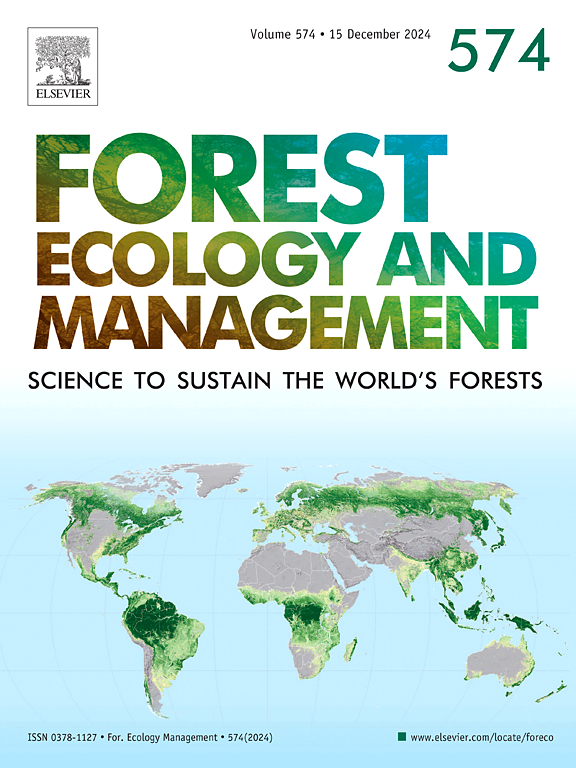森林管理对北方成熟林的森林结构和枯木的长期影响
IF 3.7
2区 农林科学
Q1 FORESTRY
引用次数: 0
摘要
芬诺斯坎迪亚的林业历史长达五个世纪,自 20 世纪中叶以来,森林砍伐一直占据主导地位。这导致森林景观发生了重大变化。在这项研究中,我们调查了皆伐对森林结构和枯木量的长期影响。我们在挪威东南部建立了十二对云杉林地,每对云杉林地都由一个成熟的、曾被砍伐过的林分和一个具有相似自然环境因子的近自然林分组成。近自然林分的枯木量是前者的2.8倍,而且处于晚期腐烂阶段的枯木比例更大。近自然林平均每公顷有 36.8 ± 9.1 立方米的倒伏枯木和 24.1 ± 6.2 立方米的立地枯木。曾被砍伐的林分的相应数字分别为 10.2 ± 2.8 立方米/公顷和 11.9 ± 3.7 立方米/公顷。枯木量较少的森林通常也具有较低的云杉老林连通性,这可能会对生物多样性产生进一步的负面影响。此外,接近自然的林分显示出更大的树木大小异质性,导致光照条件差异更大。虽然在活树体积方面没有观察到差异,但我们发现只有微弱的证据表明,以前被砍伐过的林分基部面积更大,茎干密度更高,茎干更细长,树冠更短。我们的研究结果表明,人工管理的森林在采伐成熟之前并没有形成近自然森林的典型结构。我们强调,由于森林管理历史可能与生产力和其他环境因素相混淆,因此在研究管理效果时必须进行全面的选址。在未来的研究中,像我们这样的实验设计对于测试森林管理导致的结构和枯木量差异如何转化为生物多样性、碳螯合和生态系统功能的变化至关重要。本文章由计算机程序翻译,如有差异,请以英文原文为准。
Long term effects of forest management on forest structure and dead wood in mature boreal forests
The history of forestry in Fennoscandia spans five centuries, with clear-cutting being the dominant practice since the mid-20th century. This has led to a significant transformation of the forest landscape. In this study we investigated long-term effects of clear-cutting on forest structure and dead wood volumes. We established twelve pairs of spruce forest sites in southeastern Norway, each pair constituting of a mature, previously clear-cut stand and its near-natural counterpart with similar edaphic factors. The near-natural stands had 2.8 times higher volumes of dead wood and a larger proportion of dead wood in late stages of decay. The near-natural stands had on average 36.8 ± 9.1 m3 ha−1 of downed dead wood and 24.1 ± 6.2 m3 ha−1 of standing dead wood. Corresponding numbers for the previously clear-cut stands were 10.2 ± 2.8 m3 ha−1 and 11.9 ± 3.7 m3 ha−1. Forests with lower volumes of dead wood often also had lower connectivity of old spruce forests, which potentially have further negative effects on biodiversity. Furthermore, near-natural stands displayed greater tree size heterogeneity, resulting in a wider variation in light conditions. While no difference was observed in living tree volume, we found only weak evidence for higher basal area in the previously clear-cut stands, which had a higher stem density with more slender stems and shorter crowns. Our findings suggest that managed forests do not develop structures typical of near-natural forests before they become mature for logging. We stress the importance of a thorough site selection for studies of management effects, as forest management history may be confounded with productivity and other edaphic factors. Experimental designs like ours are vital for testing how differences in structure and deadwood volumes, driven by forest management, translate into variations in biodiversity, carbon sequestration and ecosystem functioning in future studies.
求助全文
通过发布文献求助,成功后即可免费获取论文全文。
去求助
来源期刊

Forest Ecology and Management
农林科学-林学
CiteScore
7.50
自引率
10.80%
发文量
665
审稿时长
39 days
期刊介绍:
Forest Ecology and Management publishes scientific articles linking forest ecology with forest management, focusing on the application of biological, ecological and social knowledge to the management and conservation of plantations and natural forests. The scope of the journal includes all forest ecosystems of the world.
A peer-review process ensures the quality and international interest of the manuscripts accepted for publication. The journal encourages communication between scientists in disparate fields who share a common interest in ecology and forest management, bridging the gap between research workers and forest managers.
We encourage submission of papers that will have the strongest interest and value to the Journal''s international readership. Some key features of papers with strong interest include:
1. Clear connections between the ecology and management of forests;
2. Novel ideas or approaches to important challenges in forest ecology and management;
3. Studies that address a population of interest beyond the scale of single research sites, Three key points in the design of forest experiments, Forest Ecology and Management 255 (2008) 2022-2023);
4. Review Articles on timely, important topics. Authors are welcome to contact one of the editors to discuss the suitability of a potential review manuscript.
The Journal encourages proposals for special issues examining important areas of forest ecology and management. Potential guest editors should contact any of the Editors to begin discussions about topics, potential papers, and other details.
 求助内容:
求助内容: 应助结果提醒方式:
应助结果提醒方式:


